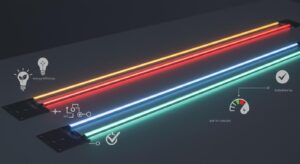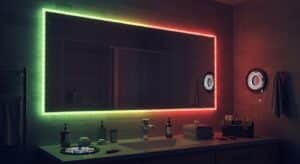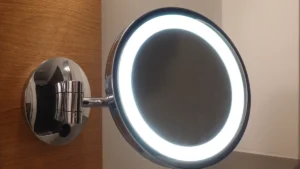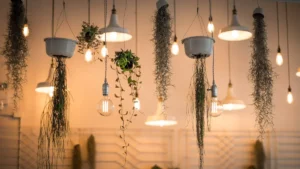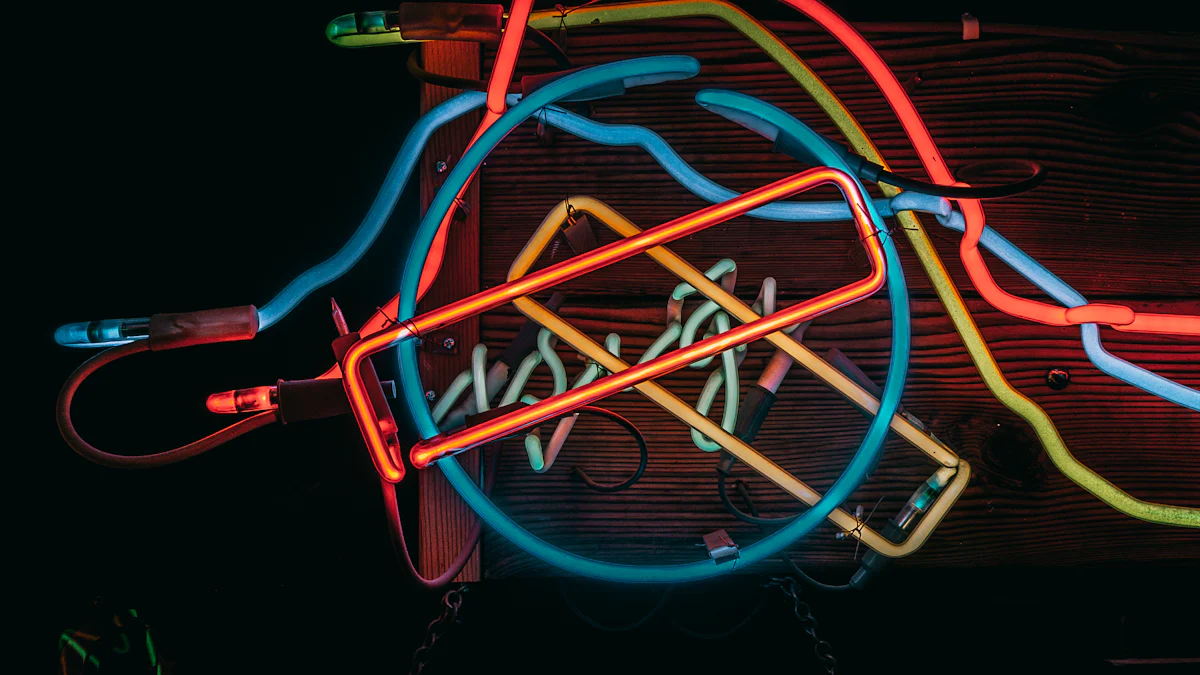
Creating your own neon sign has never been easier, thanks to the versatility of LED neon flex. These flexible lights let you shape and design stunning signs without needing advanced skills or tools. Unlike traditional neon, LED neon flex lights are safer, more energy-efficient, and budget-friendly. You can craft a vibrant, custom piece that fits perfectly in your space. Whether it’s for home décor or a unique gift, this DIY project offers endless possibilities. With just a bit of creativity and effort, you’ll bring your vision to life in no time.
Key Takeaways
LED neon flex is a safe, energy-efficient, and budget-friendly alternative to traditional neon, making it ideal for DIY projects.
Gather all essential materials and tools before starting your project to ensure a smooth crafting experience.
Design your sign carefully by sketching your ideas and measuring the space to ensure a perfect fit.
Take your time when attaching the LED neon flex to the backboard to achieve a professional-looking result.
Always test your connections and components before finalizing your sign to avoid issues like flickering lights.
Pay attention to detail during the crafting process, as precision can significantly enhance the final appearance of your neon sign.
Follow safety precautions when working with electrical components and tools to ensure a safe and enjoyable crafting experience.
Materials and Tools for DIY Neon Signs

Before diving into your project, gathering the right materials and tools is essential. Having everything ready will make the process smoother and more enjoyable. Let’s break down what you’ll need to create stunning DIY neon signs.
Essential Materials for LED Neon Flex Signs
To start, you’ll need the core components that bring your sign to life. Here’s a list of must-have materials:
LED Neon Flex: This flexible plastic tube contains LED strip lights that mimic the look of traditional neon. It’s the star of your project and can be purchased from lighting stores, online retailers, or directly from manufacturers. Choose a color or multiple colors that match your design vision.
Acrylic Backboard: This serves as the sturdy base for your sign. It holds the LED neon flex securely in place and provides a clean, professional look.
Adhesive or Mounting Clips: These help attach the LED neon flex to the backboard. Look for strong adhesives or clips that ensure the lights stay in place.
Power Supply with Transformer: LED neon flex lights require a power source to function. A transformer ensures the lights receive the correct voltage for safe operation.
Wires and Connectors: These connect the LED neon flex to the power supply. Make sure they’re compatible with your lights and transformer.
Having these materials on hand will set the foundation for your project. Each item plays a crucial role in creating a vibrant and durable sign.
Tools Required for Crafting Your Sign
The right tools make crafting your DIY neon sign easier and more precise. Here’s what you’ll need:
Scissors or Wire Cutters: Use these to cut the LED neon flex to the desired length. Ensure the cuts are clean to avoid damaging the lights.
Drill: If your design requires mounting holes in the acrylic backboard, a drill will come in handy.
Heat Gun: This tool helps bend the LED neon flex into intricate shapes or curves. It’s especially useful for detailed designs.
Measuring Tape: Accurate measurements ensure your sign looks balanced and professional.
Marker or Chalk: Use these to sketch your design on the backboard before attaching the lights. It acts as a guide during assembly.
Screwdriver: You’ll need this to secure any screws or connectors during the wiring process.
With these tools, you’ll have everything you need to bring your neon sign idea to life. They’ll help you work efficiently and achieve a polished result.
“Acquiring the perfect LED neon flex lights is the key to creating outstanding LED neon flex signage.” Keep this in mind as you select your materials and tools. The quality of your components directly impacts the final look of your sign.
Step-by-Step Guide to Making a DIY Neon Sign

Step 1: Design Your LED Neon Flex Sign
Start by sketching your vision. Think about the message or shape you want your sign to convey. Use a piece of paper or a digital design tool to draw your idea. Keep it simple if this is your first attempt at making a DIY neon sign. Complex designs can be challenging to execute without prior experience.
Once you have your design, decide on the size and colors. Measure the space where you plan to display the sign. This will help you determine the dimensions and ensure it fits perfectly. Choose colors that match your theme or the mood you want to create. For example, warm tones like red or orange can add energy, while cooler shades like blue or green offer a calming effect.
Pro Tip: Use a marker or chalk to replicate your design on the acrylic backboard. This will act as a guide when attaching the LED neon flex lights later.
Step 2: Prepare the Materials
Gather all the materials and tools you need before starting. Double-check that you have everything from the list provided earlier. Lay out your LED neon flex, acrylic backboard, adhesive, power supply, wires, and connectors. Having everything within reach will save you time and frustration.
Inspect the LED neon flex for any damage. Test the lights by connecting them to the power supply. This ensures they work properly before you begin assembly. If you notice any issues, address them now to avoid setbacks later.
Cut the LED neon flex to the lengths required for your design. Use scissors or wire cutters for clean cuts. Be precise to avoid wasting materials. If your design includes curves or intricate shapes, use a heat gun to gently bend the flex into the desired form.
Safety Tip: Always wear gloves when handling tools like scissors or a heat gun. This protects your hands and ensures a safer crafting experience.
Step 3: Attach the LED Neon Flex to the Backing Board
Now it’s time to bring your design to life. Start by placing the cut pieces of LED neon flex onto the acrylic backboard. Follow the outline you created earlier with your marker or chalk. This step requires patience and attention to detail.
Use adhesive or mounting clips to secure the LED neon flex to the board. Apply the adhesive sparingly to avoid a messy appearance. If you’re using clips, ensure they’re evenly spaced to hold the flex firmly in place. Press down gently but firmly to make sure everything sticks properly.
Work section by section to maintain accuracy. Check your progress frequently to ensure the flex aligns with your design. If something looks off, adjust it before the adhesive sets. This step is crucial for achieving a professional-looking neon sign.
Reminder: Take your time during this step. Rushing can lead to mistakes that are difficult to fix later.
Step 4: Connect the Power Supply
Now that your LED neon flex is securely attached to the backboard, it’s time to connect the power supply. This step brings your sign to life, so handle it carefully to ensure everything works as intended.
Prepare the Wires and Connectors
Locate the ends of your LED neon flex lights. Most LED neon flex strips come with pre-installed connectors, but if yours doesn’t, you’ll need to attach them manually. Strip a small portion of the wire insulation to expose the copper ends. Use connectors compatible with your lights and transformer to ensure a secure fit.Connect the LED Neon Flex to the Transformer
Attach the wires from the LED neon flex to the transformer. Match the positive (+) and negative (-) terminals correctly. This step is crucial for the lights to function properly. Use a screwdriver to tighten the connections and prevent loose wiring.Test the Connection
Plug the transformer into a power outlet and switch it on. Check if the LED neon flex lights illuminate as expected. If they don’t light up, double-check the wiring and connections. Ensure the transformer is compatible with the voltage requirements of your lights.Secure the Wiring
Once the lights are working, organize the wires to keep your sign neat. Use cable ties or adhesive clips to secure the wires to the back of the board. This prevents tangling and keeps the focus on your design.
Pro Tip: Always unplug the power supply when adjusting wires or connectors. This ensures your safety and protects the components from damage.
Step 5: Finalize and Display Your DIY Neon Sign
With the power connected, you’re ready to add the finishing touches and display your creation. This step transforms your hard work into a stunning centerpiece.
Inspect Your Sign
Take a close look at your sign. Check for any loose adhesive, uneven lighting, or misaligned sections. Fix any imperfections to give your sign a polished, professional appearance.Clean the Backboard
Wipe down the acrylic backboard with a soft cloth to remove fingerprints or smudges. A clean surface enhances the overall look of your neon sign.Choose the Perfect Spot
Decide where you want to display your sign. Consider areas with good visibility and access to a power outlet. Popular choices include walls, shelves, or windows. Use mounting hardware or adhesive strips to hang the sign securely.Show It Off
Plug in your sign and turn it on. Watch as your DIY neon sign lights up the space with vibrant colors and a unique glow. Whether it’s for a party, home décor, or a gift, your sign is sure to impress.
Fun Fact: Many creators find that making DIY neon signs becomes a hobby. Once you’ve mastered the basics, you can experiment with more intricate designs and techniques.
Congratulations! You’ve successfully created your own LED neon flex sign. Enjoy the satisfaction of seeing your vision come to life and the joy it brings to your space.
Tips for a Professional-Looking DIY Neon Sign
Creating a neon sign that looks professional doesn’t require expert skills. With thoughtful planning and attention to detail, you can elevate your DIY project to the next level. Let’s explore some tips to help you craft stunning DIY neon signs.
Planning and Designing Your Sign
A well-thought-out design is the foundation of any great neon sign. Start by brainstorming ideas that align with your vision. Think about the purpose of your sign—whether it’s for home décor, a party, or a gift. Sketch your design on paper or use a digital tool to visualize it. Keep the layout simple, especially if you’re new to working with LED neon flex lights.
When planning, consider the size and placement of your sign. Measure the space where you’ll display it to ensure it fits perfectly. Choose colors that complement the mood you want to create. For example, vibrant hues like pink or yellow add energy, while softer tones like white or blue create a calming effect.
“Designing your own LED neon sign is a fun and creative process that allows you to fully customize the look of your sign.” Keep this in mind as you plan your project. The more effort you put into the design stage, the smoother the crafting process will be.
Precision and Attention to Detail
Precision is key to achieving a polished look. When cutting the LED neon flex, make clean and accurate cuts. Use a measuring tape to ensure each piece matches your design. If your sign includes curves or intricate shapes, take your time bending the flex. A heat gun can help you achieve smooth bends without damaging the material.
Attach the LED neon flex to the backboard carefully. Follow the outline you’ve drawn and secure the flex with adhesive or mounting clips. Apply the adhesive sparingly to avoid a messy appearance. Check your work frequently to ensure everything aligns perfectly with your design.
Pay attention to the small details. Make sure the wires are neatly organized and hidden from view. This not only enhances the look of your sign but also ensures safety. A tidy and precise approach will make your DIY neon sign look like it was professionally made.
Testing and Adjustments
Testing your sign before finalizing it is crucial. Once you’ve connected the LED neon flex lights to the power supply, plug it in and check if everything works as expected. Look for any sections that aren’t lighting up or appear dim. If you notice issues, double-check the wiring and connections.
Adjustments are part of the process. If something doesn’t look right, don’t hesitate to fix it. Realign the flex, secure loose wires, or reapply adhesive if needed. Testing and tweaking your sign ensures it looks flawless when displayed.
Pro Tip: Take photos of your sign during the testing phase. This helps you spot imperfections that might not be obvious in person.
By following these tips, you’ll create a DIY neon sign that stands out. The combination of thoughtful planning, precision, and thorough testing will result in a vibrant and professional-looking piece that you’ll be proud to showcase.
Safety Precautions for Making LED Neon Flex Signs
When creating your LED neon flex sign, safety should always come first. Working with electrical components and tools can pose risks if not handled properly. By following these safety precautions, you can ensure a smooth and secure crafting experience.
Electrical Safety Tips
Electricity powers your neon sign, so handling it with care is essential. Here are some key tips to keep you safe:
Turn Off Power Before Handling Wires
Always unplug the power supply before connecting or adjusting wires. This simple step prevents accidental shocks and protects your components from damage.Use the Correct Voltage
Ensure your power supply matches the voltage requirements of your LED neon flex lights. Using the wrong voltage can cause overheating or even permanent damage to your sign.Inspect Wires and Connectors
Check all wires and connectors for wear or damage before starting. Replace any frayed wires or loose connectors to avoid short circuits or malfunctions.Secure Connections Properly
Tighten all connections to prevent loose wiring. Loose wires can lead to flickering lights or electrical hazards. A screwdriver can help you secure connectors firmly.Test in a Controlled Environment
When testing your sign, place it on a non-flammable surface away from water or other conductive materials. This reduces the risk of accidents during the testing phase.
Expert Tip: According to a DIY Neon Sign Expert, using LED neon flex instead of traditional neon makes the process much safer. LED lights eliminate the need for hazardous gases and glassblowing, reducing the risks involved.
General Safety Guidelines
Beyond electrical safety, general precautions can help you avoid injuries and ensure a successful project. Keep these guidelines in mind:
Wear Protective Gear
Use gloves when handling tools like scissors, wire cutters, or a heat gun. Gloves protect your hands from cuts, burns, and other injuries.Work in a Well-Ventilated Area
If you’re using adhesives or heating tools, ensure proper ventilation. This prevents inhalation of fumes and keeps your workspace comfortable.Handle Tools with Care
Tools like drills and heat guns require careful handling. Follow the manufacturer’s instructions and store tools safely when not in use.Avoid Rushing the Process
Take your time during each step. Rushing can lead to mistakes or accidents. Patience ensures a polished and safe final product.Seek Help for Complex Tasks
If you’re unsure about certain steps, don’t hesitate to ask for help. As a Professional Neon Sign Installer advises, seeking expert assistance for higher or more intricate installations can prevent damage and ensure safety.
Pro Tip: Keep your workspace organized. A clutter-free area minimizes the chances of tripping over tools or misplacing important components.
By prioritizing safety, you’ll not only protect yourself but also create a durable and reliable neon sign. Following these precautions ensures that your DIY project remains enjoyable and accident-free.
Troubleshooting Common Issues with DIY Neon Signs
Even with careful planning and execution, you might encounter a few hiccups while creating your DIY neon sign. Don’t worry—most issues are easy to fix with a little troubleshooting. Let’s dive into some common problems and how you can resolve them.
LED Neon Flex Strip Not Lighting Up
If your LED neon flex strip doesn’t light up, the issue likely lies in the power connection or wiring. Here’s how you can troubleshoot:
Check the Power Supply
Ensure the power supply is plugged in and switched on. Double-check that the transformer matches the voltage requirements of your LED neon flex strip. Using an incompatible transformer can prevent the lights from working.Inspect the Wiring
Look for loose or disconnected wires. Make sure the positive (+) and negative (-) terminals are correctly aligned. Tighten any loose connections with a screwdriver to secure the wiring.Test the LED Neon Flex
Disconnect the strip and test it with another power supply, if available. This helps you determine whether the issue is with the strip or the transformer.Examine for Damage
Inspect the LED neon flex for visible damage, such as cuts or tears. Damaged sections may need replacement to restore functionality.
Quick Tip: Always unplug the power supply before handling wires or connectors to avoid electrical hazards.
Uneven Lighting on the Sign
Uneven lighting can make your neon sign look less appealing. This issue often stems from improper installation or faulty components. Here’s what you can do:
Check the LED Neon Flex Placement
Ensure the LED neon flex is evenly attached to the backboard. Gaps or uneven pressure can cause inconsistent lighting. Reattach any loose sections using adhesive or mounting clips.Inspect the Power Distribution
Uneven lighting might result from insufficient power reaching certain parts of the strip. Verify that all connectors are secure and the transformer provides adequate voltage.Look for Damaged LEDs
Examine the strip for dim or non-functioning LEDs. If you find damaged sections, you may need to replace that part of the strip.Adjust the Environment
Sometimes, external factors like shadows or reflections can create the illusion of uneven lighting. Test your sign in different lighting conditions to rule out environmental causes.
Pro Tip: Use high-quality LED neon flex strips to minimize the risk of uneven lighting. These strips are more durable and reliable, ensuring a consistent glow.
Adhesive or Mounting Problems
If the LED neon flex doesn’t stay securely attached to the backboard, it can affect both the appearance and functionality of your sign. Here’s how to address this:
Reapply Adhesive
If the adhesive isn’t holding, clean the backboard and the LED neon flex with a soft cloth to remove dust or grease. Apply a fresh layer of strong adhesive and press the flex firmly into place.Use Mounting Clips
For added security, consider using mounting clips instead of adhesive alone. Clips provide a stronger hold and are less likely to fail over time.Check the Backboard Material
Some materials, like rough or uneven surfaces, may not bond well with adhesive. If this is the case, switch to a smoother backboard, such as acrylic, for better results.Avoid Overheating
Excessive heat from tools like a heat gun can weaken adhesives. Work carefully and avoid prolonged exposure to heat when shaping the LED neon flex.
Fun Fact: LED neon flex signs are more flexible and durable than traditional glass neon signs, making them easier to mount and maintain.
By addressing these common issues, you’ll ensure your neon sign looks and functions as intended. Troubleshooting might take a little extra time, but the end result will be worth it—a vibrant, glowing sign that lights up your space beautifully.
Crafting your own neon sign with LED neon flex is an exciting and fulfilling project. You get to combine creativity with practicality, resulting in a unique piece that reflects your style. By following the steps outlined, you’ll avoid common issues like flickering lights or loose attachments. Take your time, test your sign thoroughly, and make adjustments as needed. Whether it’s for your home, a party, or a gift, your DIY neon sign will stand out and impress. Start today, and let your imagination shine bright!
FAQ
How long does it take to make a DIY LED neon sign?
The time it takes depends on your experience and the complexity of your design. If you’re new to this, expect to spend around 3-4 hours completing your first sign. For those with more experience, it might only take 30-45 minutes. Start with simple designs to build your confidence and skills. Mistakes are part of the learning process, so don’t worry if it takes longer at first.
Can I use neon sign kits for my project?
Yes, neon sign kits are a great option, especially for beginners. These kits usually include essential materials like LED neon flex, a backing board, and a power supply. They simplify the process by providing everything you need in one package. If you’re unsure about sourcing individual components, a kit can save you time and effort.
What’s the difference between LED neon flex and traditional neon?
LED neon flex is safer, more energy-efficient, and easier to work with than traditional neon. Traditional neon requires glass tubes and hazardous gases, while LED neon flex uses flexible plastic tubing with LED lights inside. This makes it ideal for DIY projects, as it eliminates the need for specialized tools or skills.
Can I create custom neon signs with LED neon flex?
Absolutely! LED neon flex is perfect for making custom neon signs. You can design unique shapes, letters, or patterns to match your vision. Whether it’s a name, logo, or decorative art, the flexibility of LED neon flex allows you to bring your ideas to life. With the right tools and materials, the possibilities are endless.
Do I need special tools to bend LED neon flex?
No, you don’t need specialized tools, but a heat gun can help. It softens the material, making it easier to bend into intricate shapes. If you don’t have a heat gun, you can still create simple designs by gently shaping the flex with your hands. Just take your time to avoid damaging the lights.
Are neon sign kits suitable for kids or beginners?
Neon sign kits are beginner-friendly, but adult supervision is recommended for kids. The process involves tools like scissors, drills, and heat guns, which require careful handling. If you’re working with children, focus on simpler designs and ensure safety precautions are followed.
How do I ensure my sign looks professional?
Pay attention to detail during each step. Use a marker to outline your design on the backing board before attaching the LED neon flex. Make clean cuts and secure the flex evenly with adhesive or clips. Test the lights before finalizing the sign to check for any issues. Taking your time and being precise will result in a polished, professional-looking sign.
What should I do if my LED neon flex doesn’t light up?
First, check the power supply and ensure it’s plugged in and switched on. Verify that the transformer matches the voltage requirements of your LED neon flex. Inspect the wiring for loose connections or damage. If everything seems fine, test the flex with another power supply to identify the issue.
Can I reuse materials from old neon sign kits?
Yes, you can reuse materials like the backing board, power supply, and even some sections of LED neon flex if they’re in good condition. Before reusing, inspect each component for wear or damage. Reusing materials is a cost-effective way to create new designs without starting from scratch.
Where can I display my DIY neon sign?
You can display your neon sign almost anywhere with access to a power outlet. Popular spots include walls, shelves, windows, or even as part of event décor. Make sure the location is safe and secure, especially if the sign will be in a high-traffic area.
Pro Tip: Experiment with different placements to find the perfect spot where your sign can shine the brightest.
See Also
Creating Your Unique Neon LED Sign From Scratch
Steps to Design and Construct LED Neon Signs
Installing LED Modules for Channel Letter Signage
